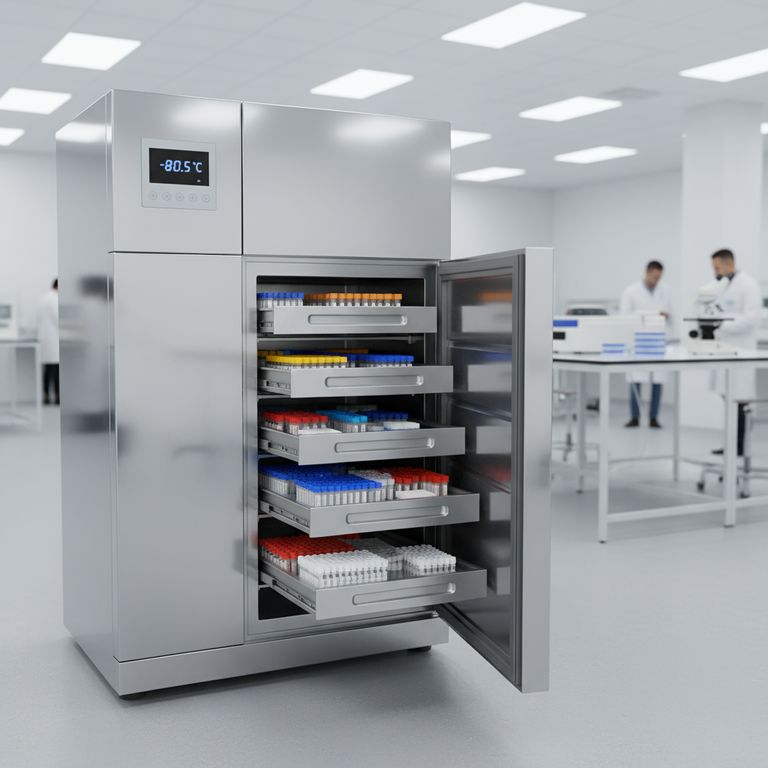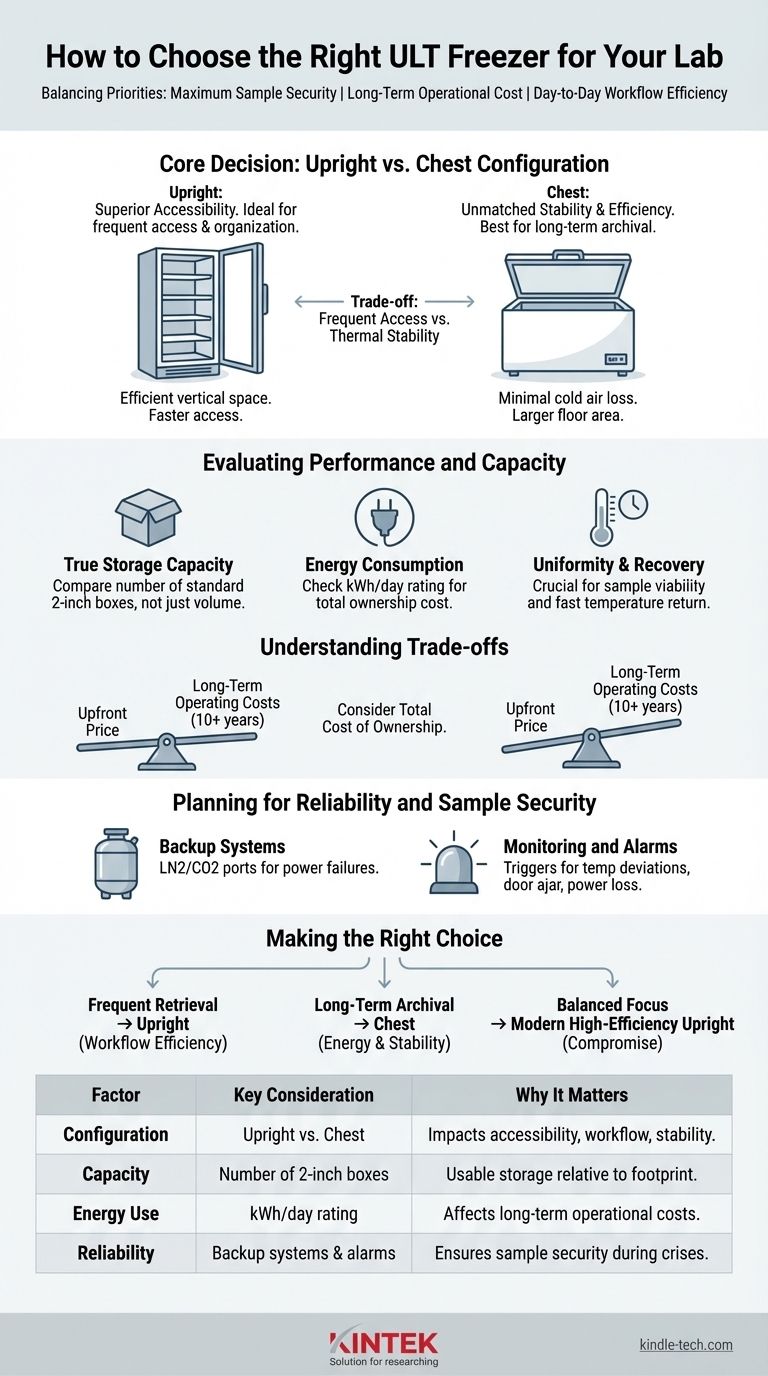Choosing the right Ultra-Low Temperature (ULT) freezer is a critical decision that directly impacts the integrity of your research and your lab's operational budget. The most important factors to consider are the physical configuration (upright vs. chest), total storage capacity relative to its footprint, long-term energy consumption, and the reliability features that ensure sample security during unforeseen events like a power failure.
Your decision is not merely about buying a cold box; it's about balancing three competing priorities: maximum sample security, long-term operational cost, and day-to-day workflow efficiency. The best choice will depend on which of these is most critical for your specific laboratory environment.

Core Decision: Upright vs. Chest Configuration
The physical design of the freezer is the first and most significant decision point, as it dictates how your team will interact with it daily and how it performs thermally.
The Case for Upright Freezers
Upright freezers are the most common choice for active research labs due to their superior accessibility. Samples are stored on shelves, making them easy to organize, inventory, and retrieve quickly.
This configuration is ideal for workflows that require frequent access to different samples, minimizing the time the door is open for any single retrieval.
The Case for Chest Freezers
Chest freezers are unmatched in temperature stability and energy efficiency. Because cold air is dense and sinks, very little is lost when the top-loading lid is opened.
This makes them the superior choice for long-term archiving where samples will be accessed infrequently. Their design inherently protects sample integrity and reduces electricity costs.
The Space Footprint
Consider your available lab space. Upright freezers utilize vertical space efficiently, fitting into tighter floor plans.
Chest freezers require a larger, uninterrupted floor area and can be more difficult to place. However, their top surface can sometimes be used for low-profile benchtop work if needed.
Evaluating Performance and Capacity
Beyond the basic shape, you must evaluate the freezer's performance metrics. These numbers directly translate to sample safety and your lab's utility bills.
True Storage Capacity
Look beyond the advertised internal volume (liters or cubic feet). The most useful metric is the number of standard 2-inch boxes the freezer can hold.
A well-designed interior racking system can significantly increase usable capacity without increasing the freezer's external footprint. Always compare box capacity.
Energy Consumption
A ULT freezer is one of the most energy-intensive pieces of equipment in a lab. Manufacturers provide an energy consumption rating, typically in kilowatt-hours per day (kWh/day).
Comparing this number between models is critical for understanding the total cost of ownership. A lower kWh/day rating will result in significant savings over the freezer's decade-plus lifespan.
Temperature Uniformity and Recovery
Uniformity ensures that samples in every corner of the freezer are held at the setpoint, preventing temperature gradients that could compromise viability. Recovery is the speed at which the freezer returns to its setpoint after a door opening.
A fast recovery time is crucial for labs with frequent access, as it minimizes the duration of temperature fluctuations your samples are exposed to.
Understanding the Trade-offs
Every ULT freezer design involves compromises. Being aware of them allows you to make an informed choice rather than a surprising one.
Frequent Access vs. Thermal Stability
This is the central trade-off between upright and chest models. Upright freezers offer excellent access at the cost of greater temperature loss each time the door is opened.
Chest freezers provide superior thermal stability, protecting samples from temperature swings, but make it much harder to retrieve a specific sample from the bottom.
Upfront Price vs. Long-Term Operating Costs
The initial purchase price is only one part of the equation. A less expensive freezer may have poor insulation and an inefficient compressor, leading to high electricity bills.
Always calculate the Total Cost of Ownership, factoring in the purchase price plus the estimated energy cost over 10 years. A more expensive, high-efficiency model is often cheaper in the long run.
Planning for Reliability and Sample Security
A freezer's primary job is to protect its contents. Features that ensure this protection during a crisis are non-negotiable.
Backup Systems
The most significant risk to your samples is a power failure. Look for freezers that have ports for, or are compatible with, backup systems.
These typically use liquid nitrogen (LN2) or carbon dioxide (CO2) to keep the chamber cold for an extended period until power is restored or samples can be moved.
Monitoring and Alarms
On-board monitoring is essential. The freezer must have alarms that trigger for temperature deviations, door-ajar events, and power failures.
Modern systems can connect to the lab's network to send email or text alerts, ensuring key personnel are notified of a problem 24/7, even when off-site.
Making the Right Choice for Your Lab
To select the ideal freezer, align your choice with your lab's primary operational goal.
- If your primary focus is frequent sample retrieval and organization: An upright freezer is the superior choice for its workflow efficiency and ease of inventory management.
- If your primary focus is long-term, low-cost archival: A chest freezer offers the best energy efficiency and temperature stability, protecting samples while minimizing operating expenses.
- If your primary focus is balancing cost and daily usability: A modern, high-efficiency upright model often provides the best compromise between accessibility and manageable energy consumption.
Choosing the right ULT freezer is an investment in the security and future of your lab's most valuable assets.
Summary Table:
| Factor | Key Consideration | Why It Matters |
|---|---|---|
| Configuration | Upright vs. Chest | Impacts accessibility, workflow efficiency, and thermal stability. |
| Capacity | Number of standard 2-inch boxes | Determines usable storage relative to footprint. |
| Energy Use | kWh/day rating | Directly affects long-term operational costs. |
| Reliability | Backup systems (LN2/CO2) & alarms | Ensures sample security during power failures or temperature deviations. |
Protect your lab's most valuable samples with the right ULT freezer. The choice between an upright and chest model directly impacts your sample security, operational costs, and daily workflow. At KINTEK, we specialize in providing reliable lab equipment, including ULT freezers, tailored to meet the specific needs of research laboratories. Our experts can help you evaluate your requirements for capacity, energy efficiency, and critical backup systems to ensure your samples are always safe. Contact us today to find the perfect freezer solution for your lab and secure your research's future. Get in touch now!
Visual Guide

Related Products
- 408L Advanced Vertical Laboratory Ultra Low Temperature Freezer for Critical Research Material Preservation
- 508L Advanced Vertical Ultra Low Temperature Freezer for Critical Laboratory Storage
- 58L Precision Laboratory Ultra Low Temperature Upright Freezer for Critical Sample Storage
- 158L Precision Vertical Ultra Low Freezer for Laboratory Applications
- 808L Precision Laboratory Vertical Ultra Low Temperature Freezer
People Also Ask
- What are ultra low temperature freezers used for? Preserving Critical Biological Samples for Decades
- What factors should be considered when selecting an ultra-low temperature freezer? Ensure Sample Integrity and Long-Term Value
- What advantages do ultra-low temperature freezers offer? Ensure Long-Term Sample Integrity and Reliability
- How do Ultra-Low Temperature freezers ensure the integrity of microbiological samples? Maintain Stability for Critical Research
- What temperature range do Ultra-Low Temperature freezers maintain? The -80°C Standard for Sample Integrity



















